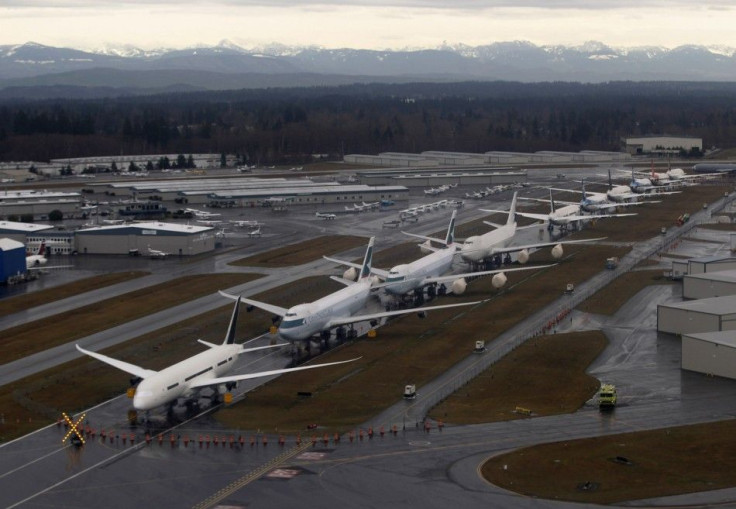Dreamliner: Boeing says Flaw could affect 55 Planes

(REUTERS) - About 55 Boeing Co. 787 Dreamliner jets may have a recently discovered flaw in the fuselage, the company said on Wednesday, while reiterating that the world's first carbon-plastic passenger plane is safe to fly.
In the latest in a series of glitches in developing the revolutionary jet, Boeing earlier this month reported signs of delamination on a support structure in the rear fuselage. Delamination occurs when repeated stress causes laminated composite materials to begin to separate.
The company is examining a backlog of assembled Dreamliners to see whether they show similar signs of stress, which it has blamed on incorrect shimming -- a process planemakers use to fill tiny gaps when aircraft are built.
All the airplanes that were built up to plane 55 have the potential for the shimming issue, James Albaugh, chief executive officer of Boeing Commercial Airplanes, told reporters during a media roundtable in Singapore.
Albaugh said the problem was very fixable.
We are in the process of fixing the airplanes that are in the (production) flow, he said. There is no safety or flight issue on the airplanes that we have delivered.
Although composite parts have been in use for years, the 787 is the first airliner built mainly out of the new materials, which help airlines save fuel by reducing aircraft weight.
Albaugh said the inspections might affect delivery of the aircraft to customers in the short term, but Boeing still expects to meet its target for this year.
The first six aircraft produced are generally test models.
Analysts have said the discovery of the flaw after the first delivery of the aircraft last September has raised questions about whether Boeing can meet what many already saw as an ambitious plan to raise output to 10 Dreamliners a month by the end of 2013.
People pretty much understood when the news came out initially that it would affect the majority of the Dreamliners that had been produced, because it was a workmanship issue. So I don't think this will be too much of an overhang on the stock,
said Wedbush Securities analyst Kenneth Herbert.
Boeing currently makes 2.5 Dreamliners each month and expects to boost monthly output to 3.5 in the second quarter and to five by year-end.
Herbert said many aviation experts and stock analysts expect Boeing to miss its production rate target next year and have already priced that view into the company's shares.
DECISION ON 787 STRETCH BY YEAR-END
Boeing has so far delivered five of the aircraft to Japan's All Nippon Airways, which put the plane into regular passenger service starting on December 1. Due to production problems, that was three years later than originally planned.
ANA said Boeing had contacted the airline to say there were no safety issues involved in shimming and to give a general indication of the inspection procedure. ANA said its five Dreamliners are operating normally.
Japan Airlines has already said it no longer expects its first Dreamliner by the end of February as a result of the manufacturing glitch.
The 787 problem comes as Boeing rival Airbus investigates the cause of cracks in part of the wings of its A380 superjumbo. It also insists its jets are safe.
Airbus Chief Executive Officer Tom Enders pledged last week the plane-maker would apply lessons from the A380 glitches to the development of the A350, which is the European company's carbon-composite answer to the 787 Dreamliner.
Boeing will decide whether to go ahead with plans to produce a stretched, or longer, version of the 787 Dreamliner by the end of this year, Albaugh said.
Most aircraft analysts expected Boeing to push ahead with the 787-10, which would carry around 320 people, 40 more than the longest 787 version currently on offer, the 787-9.
The 787 and A350 address the mid-sized segment of the market, which is expected to number several thousand aircraft in coming decades as airlines renew fleets to save fuel and open up new routes.
Airbus and Boeing are also battling to maintain a roughly equal share of the single-aisle aircraft segment, the industry's largest by volume, after updating their best-selling 150-seat jets with new engines.
Airbus took the lead last year with strong sales of its A320neo, but Boeing is redressing the balance with its 737 MAX.
We have over 1,100 commitments (for the 737 MAX), and our goal this year is to turn all of those into firm orders, Albaugh told reporters, adding that Boeing aimed for a couple thousand firm orders by the time the updated aircraft enters service in 2017.
If there really is a softening in the economy, you could see some deferrals, you could see some people cancelling and you could see fewer orders, he said.
Underlining concerns about the economy, Singapore Airlines said on Wednesday it was cutting cargo capacity by 20 percent because of weak demand and high fuel prices.
(Additional reporting by Tim Hepher and Kyle Peterson; Editing by Anshuman Daga, Lisa Von Ahn and John Wallace)
© Copyright Thomson Reuters {{Year}}. All rights reserved.






















